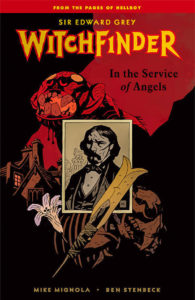 As part of my revisiting in more detail the various comic series that makes up the overall Hellboy Universe, this time I look at Sir Edward Grey: Witchfinder.
As part of my revisiting in more detail the various comic series that makes up the overall Hellboy Universe, this time I look at Sir Edward Grey: Witchfinder.
Grey is a Victorian-era occult investigator who was mentioned in the Hellboy series before getting his own stories. We were told, and later get to see the episode, that Grey had been appointed the Queen’s London agent to look into occult matters. And in early 1879, he stops an attempt against Queen Victoria by a trio of witches and is knighted. Hence people calling him “Witchfinder.” The Hellboy Companion gives an overview of his life, and there is a lot that happened that could have been turned into stories, either prose or comics.
For me, Grey is clearly inspired by various early occult detectives like John Silence and Carnacki, Victorian ghost stories, and occult beliefs of the time, like the Theosophists. He didn’t have an organization behind him like Hellboy does, so he had to figure things out by himself, or occasionally get help in particular stories. His main contact seems to be from a trio of police coroners.
A group he had to deal with is the masonic-like Heliopic Brotherhood of Ra, who later went underground. Offshoots like the Osiris Club and Oannes Society would be dealt with later in the Hellboy series. Later Grey fell out of favor with the Queen over the Jack the Ripper case, and goes off on his own, and we would learn his ultimate fate later in the Hellboy series, and he appears later to help Hellboy during his time in Hell.
Grey has a series of stories collected into six trade paperbacks by Dark Horse, and sadly, I don’t think we’ll get more. I do like that we had different artists with each series. While I perfer a consistant creative team, I thought having different artists for each story gave each one a unique feel.
The first volume is In the Service of the Angels. Set in 1879, a little after Grey being knighted, a series of strange murders that appear to be done by an unknown creature occur. The targets are members of a recently returned expedition (sort of like the so-called “curse of King Tut“). This expedition had found the remains of a previously unknown civilization. Maybe Hyperborean. They had brought back a strange skeleton, apparently one of the slave race created by the Hyperboreans who had risen up and destroyed them. Grey, with the help of others (some of whom I thought we’d see more of), is able to stop it. But things go tragically for several. This volume also gives us the tale of Grey stopping the witches and a story of a previous witchfinder.
Volume 2 is Lost and Gone Forever and features the artwork of John Severin. This one is set in the American West in 1880, which makes Severin appropriate. Grey’s on the trail of an English lord, and along the way finds some strange goings-on. A weird white girl is seen preaching to the native tribes, with a sinister purpose. There are bizarre disappearances. And zombies. We also learn of Grey’s adventure with a werewolf as a youth that started him on his path. He teams up with an old hand gunman and a strange man who may be 80 years old, but looks less then 30. I thought it an interesting point they showed that Grey was the subject of dime novels.
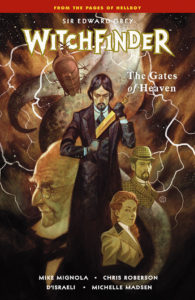 Volume 3 is The Mysteries of Unland, set in 1881 and has Grey looking into a unusual town in England and its weird wetlands where eels dwell. The town is the source of Poole’s Elixir, and when strange deaths are tied to it, and it seems related to the eels, Grey looks into it. Some elements of the story make me think of H.P. Lovecraft‘s Innsmouth. The epilogue with Ape Sapien was a nice touch.
Volume 3 is The Mysteries of Unland, set in 1881 and has Grey looking into a unusual town in England and its weird wetlands where eels dwell. The town is the source of Poole’s Elixir, and when strange deaths are tied to it, and it seems related to the eels, Grey looks into it. Some elements of the story make me think of H.P. Lovecraft‘s Innsmouth. The epilogue with Ape Sapien was a nice touch.
Volume 4 is City of the Dead, set in 1882 and has Grey dealing with vampires. In fact, a certain vampire who will return in the Hellboy series. And the problem with these vampires is such that Grey has to team up with the Heliopic Brotherhood of Ra.
Volume 5 is The Gates of Heaven, set in 1884. Several things I liked about this one is that Grey meets with some interesting groups and individuals. One is the Foundry, which is using Hyperborean tech to build aeronefs, subs, and tanks. And I loved how their logo has similar elements to the Bureau for Paranormal Research and Defense’s logo. I’m not sure if it was ever clear what happened to the Foundry after this time.
The second thing was Grey meeting the British Paranormal Society, which Prof. Trevor Bruttenholm was part of before he founded the BPRD. And one of their members is Simon Bruttenholm, who I think is the professor’s uncle. And the third is meeting Panya, who will later join the BPRD after being rescued from the Oannes Society (here she is under the care of the HBR).
In this story, a madman experimenting with Hyperborean tech opens up a gateway and threatens the world, but Grey with the Foundry and BPS puts an end to it, though not without lose.
Volume 6 is The Reign of Darkness, and has Grey going up against Jack the Ripper, the case that led him to leave the service of Queen Victoria! This one also has Sarah Jewell, who we first saw in the Black Flame series, which occurred after this. As expected, we learn who Jack the Ripper was and the sinister purpose behind his crimes. The Heliopic Brotherhood is involved, as are others in the government. Hence why he left. Now he has to embark on his own path, and continue his fight against the HBR.
I’ve enjoyed this series for many reasons. We are able to get Victoria-era stories, plus we get early hints to things that will have more meaning in the Hellboy/BPRD storylines. I wish we could get more, but I guess not. But enjoy them anyway.

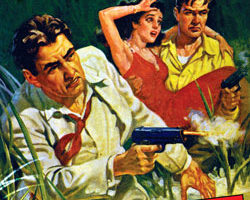
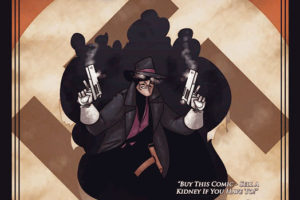
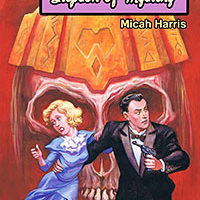
Your comments